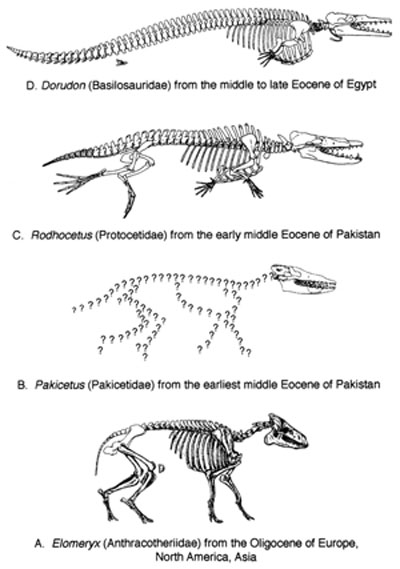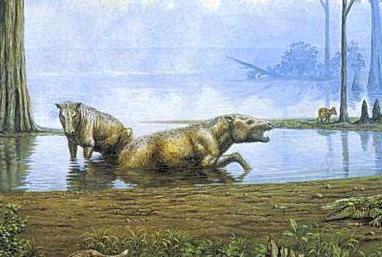Good tidings and well-wishes and once again, I must apologize for my lengthy, school-induced posting drought!
As a result of my earlier posts on Coryphodon, Pezosiren, and Estemmenosuchus, it’s fair to say TTT has acquired a history of discussing semi-aquatic and superficially hippo-like animals (though Brian’s blog certainly has mine bested in this field). To shake things up just a wee bit for this particular ‘spotlight’, I’d like to shed some coverage upon Elomeryx sp., an animal which, shockingly, may actually be related to modern hippos! However, as we shall see, this particular creature is arguably much better known for its theoretical kinship with another group of contemporary mammals: the Cetacea (which is hardly surprising, for, as I’ve argued earlier, cetaceans are rapidly becoming the “nonavian theropods” of paleo-mammology).

A reconstruction originally compiled by Philip Gingerich wherein Elomeryx stands in as a model of the earliest artiodactylian ancestors of archaic whales.
Elomeryx is the oldest known constituent of the Anthracotheriidae, a family which, as defined by the genus’ arrival, first evolved in the Mid-Eocene of Eurasia. The group subsequently spread throughout both of the region’s continents along with Africa and, to a lesser extent, North America before its youngest known member, Merycopotomas, went extinct during the late Pliocene. Presumably, the group’s decline in the old world is the result of the spread of primitive hippos whilst their limited tenure in the western hemisphere has often been attributed to a lack of diversity and widespread alterations in habitat.

Elomeryx reconstruction
The Anthracotheriidae is divided into three subfamilies, the Anthracotheriinae, the Microbunodontinae, and the Bothriodontinae, with Elomeryx itself hailing from the latter assemblage. According to Donald G. Kron and Earl Manning, this group is defined on the basis of the following characteristics: ”[C]anine tusklike; upper molar mesostyles fully invaded by transverse valley; mesostyle not forming a fully developed cusp in consequence; and ectoloph completely W-shaped.”

E. crispus skull hailing from Southwestern France.
(Do check out this paper for more details on the above image)
Discovered by Othneil Charles Marsh during the famed “bone wars” of the late nineteenth century (on a side note, I’d most heartily recommend Mark Jaffe’s excellent book on the subject to those interested in this fascinating period of U.S. paleontology), Elomeryx is noteworthy for, among other things, its sexual dimorphism (though its hardly the only Anthracothere to exhibit such diversity in this regard): male specimens sport serrated posterior edges on their upper canines. Alongside this feature, the genus may be recognized by its short rostrum, five-cusped molars, looplike mesostyle, a diestemata-free premolar row, and the presence of accessory cusps on premolars in derived species. Intriguingly, some authors maintain that Elomeryx is paraphyletic, an assertion whose verification will require a more intensive study of North American specimens. The genus is generally considered to have been a consumer of freshwater vegetation on the basis 0f its dental morphology, though it should be noted that its relative lack of specializations render any effort to precisely reconstruct its lifestyle elusive at best.
Earlier, I treaded lightly whilst discussing the phylogenetic affiliations of the Anthracotheriidae. This discretion stems from the fact that these relations have become the focal point of considerable controversy in recent years. While essentially everyone is in agreement over the well-evidenced notion that hippos are the closest living relatives of cetaceans, the precise nature of this linkage is hardly “crystal clear”. The fact that the first Archaeocetes predate Elomeryx in the fossil record all but rules out the possibility that Anthracotheres could have given rise to these earliest of whales, depending, of course, on whether or not future fossil evidence will contradict this assertion. The situation is complicated further by a recent paper which argues that the Anthracotheriidae is akin to the Entelodontoidea and the enigmatic Andrewsarchus which, together, form the proposed Cetacodontamorpha lineage which, according to Michelle Spaulding, Maureen O’Leary, and John Gatesy, is defined as the ”Cetancodonta plus all extinct taxa more closely related to extant members of Cetancodonta than to any other living species”.




















